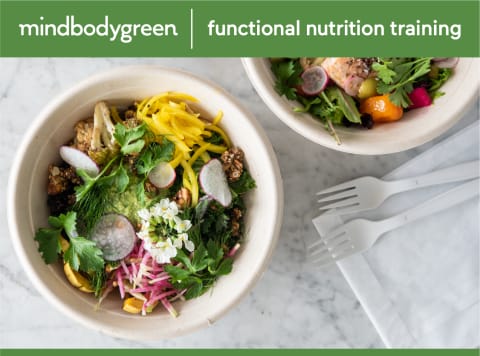Advertisement
18:6 Fasting: Pros, Cons, Sample Eating Schedule & Expert Tips


Intermittent fasting (IF), or time-restricted feeding, can yield profound benefits like boosting energy, increasing cognitive function, and reducing inflammation when done properly.
But not all types of fasting are equal. You have your 16:8 schedule, 20:4 schedule, and more—all of which restrict feeding windows differently and have a unique impact on metabolic health. Let's take a closer look at the benefits and risks associated with an 18:6 fasting schedule.
What is 18:6 fasting?
Following a 18:6 fasting schedule means that you fast for 18 hours a day and eat for six hours a day.
"[18:6] is a term used to explain a person's fasting window and eating window," Mindy Pelz, D.C., author of Fast Like a Girl, tells mindbodygreen. "Eighteen hours is the length of time they consistently go without food, and six hours is the time period in which they eat their meals," she says.
Researchers posit1 that the average American consumes the majority of their caloric intake within a 12-hour feeding window. That makes 18:6 a moderate-to-advanced fasting option—it's more restrictive than 16:8 fasting but not as intense as alternate-day fasting or the 5:2 diet.
As such, according to Madiha Saeed, M.D., author of The Holistic Rx, the 18:6 IF schedule might be beneficial for someone experiencing a weight loss plateau on the 16:8 schedule.
And the benefits of this type of fasting span beyond weight loss. "Longer fasts can reset your system," says Saeed. "Modern science has now found so many physical benefits for fasting. Simply going without food is anti-inflammatory2, anti-tumor3, and anti-aging4."
Summary
Benefits of this fasting schedule:
It supports digestion.
The different stages of fasting support an important digestive mechanism called the migrating motor complex (MMC) that controls stomach and small intestinal contractions in a cyclical pattern over a period of about two hours, says Saeed. Spacing out your meals, as you do on an 18:6 fasting schedule, can enhance MMC function5.
Saeed says fasting also stimulates the production of cyclic adenosine monophosphate (c-AMP)6, a crucial messenger that supports gut health.
It promotes weight loss.
When we go hours without food, it can increase fat-burning lipolysis, enhance metabolic flexibility, and accelerate your metabolic rate7. Fasting also stimulates pathways that build new mitochondria8 and enhance cellular energy, Saeed says.
As for the weight loss results you can expect on 18:6, Pelz notes that she has seen clients lose five to 10 pounds in a month while following this fasting regimen. Saeed notes that men and women may experience weight loss differently, though. "For men, they can start fasting 15 hours a day and drop 30 pounds in a month," she says. "Women typically don't lose weight that fast."
It boosts cognitive function.
Pelz says after 18 hours in a fasted state, your body will experience a wide array of positive short-term benefits like enhanced mental clarity and cognitive function9.
Fasting is also being researched as a preventive tool against cognitive decline and disorders like dementia10. "Insulin resistance, obesity, and metabolic syndrome are all associated with cognitive decline...and fasting reduces those conditions," Jason Fung, M.D., a nephrologist and intermittent fasting expert, previously told mindbodygreen.
Fasting (especially when paired with a keto eating pattern) can also stimulate ketone production, which has been shown to boost neural metabolism11, giving you more energy and mental clarity, Pelz says.
Saeed shares that IF has also been shown to affect the growth hormone brain-derived neurotrophic factor (BDNF)12, which plays a role in stimulating new brain cells and the boosting performance of existing neurons.
It supports the body's detox systems.
Saeed says IF, specifically the 18:6 model, activates the Nrf2 gene pathway13 that improves detoxification and stem cell activation. This triggers new cell formation, increases mitochondrial function, and promotes autophagy—the body's natural cleansing process that removes damaged proteins, clears damaged cellular parts, and assists with cellular repair and regeneration.
"There is debate at what hour of fasting autophagy kicks in, but most believe it kicks in at around the 17-hour mark," says Saeed.
It boosts immune system and reduces inflammation.
"Fasting improves the immune system [by] reducing inflammation14 and reduces immunosenescence15—the gradual deterioration of the immune system over time," Saeed shares.
She adds that restricting your eating window has also been shown to help protect against conditions that have an inflammatory component, such as cardiovascular diseases16.
What 18:6 fasting is like, from someone who does it:
The most difficult hurdle for me was being consistent with my eating window. I typically fast between 4 p.m. and 10 a.m. With a busy schedule, these mid-day hours are often the most chaotic. Meal prepping a large, high-protein breakfast (50-60% of my daily caloric intake) has been helpful in overcoming this unpredictability.
—Glen T.
Sample schedule.
There are numerous ways to structure your 18:6 eating plan. Here's a sample schedule to get you started and provide some structure to your fast.
Early eating window meal plan:
- Black coffee or tea (no milk or sugar)
- 8 a.m. Scrambled eggs with mixed veggies and whole wheat toast
- 10 a.m. Cut-up apple with natural peanut butter
- 12 p.m Stir-fry with veggies, lean protein, and brown rice.
- End at 2 p.m. Rice cake with cottage cheese and cut-up veggies
Midday eating window meal plan:
- Black coffee or tea (no milk or sugar)
- 11 a.m. Unsweetened yogurt, fruit, and granola
- 1 p.m. Hearty salad with olive oil and lean protein
- 3 p.m. Banana and all-natural peanut butter
- End at 5 p.m. Tuna and veggies
Late eating window meal plan
- Black coffee or tea (no milk or sugar)
- 1 p.m. Avocado toast with whole wheat bread
- 2 p.m. Lentil soup with veggies
- 4 p.m. Turkey sandwich on whole wheat
- End at 6 p.m. Vegan zoodles
Tips for this fasting plan.
As mentioned earlier, 18:6 is more restrictive and difficult to follow than other types of fasting that have longer eating windows. Here are some tips to make it more doable:
Go slowly.
Like any other lifestyle change, gradual steps can be more sustainable than diving in headfirst. Saeed recommends first starting out with a 12-hour fasting window, then gradually achieving 14 and 16 hours before making your way to 18 hours. And you can always return to these fasting plans if you find 18:6 too difficult.
Find your reason.
Saeed says you're far more likely to achieve your goal if you write it down and get clear on your "why." "Determine your goals for fasting," she says. "What are you trying to achieve? Weight loss, improved metabolic flexibility, reduced insulin or leptin resistance, resetting your poor eating habits and lifestyle habits, anti-aging, lowering inflammation?"
The idea is that if you have a purpose in mind, you'll fast with more intention and thus be more likely to stick to the plan.
Think positively.
You're more likely to successfully adapt to an IF lifestyle if you believe you can do it. "Wake up in a state of gratitude," Saeed says. "Immediately wake up and say 10 things you are thankful for every day. Work on changing limiting beliefs and replacing them with positive affirmations."
Stick to a schedule.
Saeed suggests picking a schedule that supports your lifestyle and sticking to it. For most folks, that would look something like starting your first meal at 12:30 p.m. and ending your eating window at 6:30 p.m. She urges folks starting IF to maintain their normal daily schedule and to keep busy.
Eat the right foods.
It's a common misconception that you can still reap the benefits of IF while loading your body with oversize portions of your favorite comfort foods.
"Focus on nutrient-dense foods with protein, healthy fats, plenty of fiber, lots of spices, and eating the rainbow," says Saeed. She recommends avoiding processed foods that contain added sugar, gluten, seed oils, and chemical food additives. Breaking up longer fasts by drinking a cup of broth can also help stave off hunger (though it will technically "break" your fast).
Some nutrient-dense recipes to try while fasting include:
- A nutrient-dense oat bowl for breakfast
- A hearty black bean soup for lunch
- Blueberry, prosciutto, and goat cheese flatbread for a snack
- Plant-based Thai noodles for dinner
Give hunger pangs time to pass.
Hunger pangs might be the most distracting bodily mechanism in the world. But if you don't give in to them right away, you'll be promoting your body's fat-burning processes, according to Saeed.
"The prominent hunger hormone ghrelin, which gets your stomach to growl with the secretion of digestive enzymes, spikes for about 20 minutes to compel you to eat," she says. "After that period of time, your body realizes it's not getting food, so the ghrelin spike will subside and you will start to accelerate fat burning and ketone production."
If you feel dizzy or lightheaded at any point, it's best to stop fasting and eat some food.
Control stress.
A break in your eating routine may understandably trigger a stress response. Saeed encourages you to use stress management techniques like meditation, mindfulness, grounding, belly breathing, nature, exercise, and tech breaks to get through it.
Manage detox symptoms.
Detoxing may be one of IF's most prized benefits, but it can initially present itself in uncomfortable ways, according to Saeed.
"When you hit ketosis for the first few times, you can get the 'keto flu.' Symptoms include fever, muscle aches, constipation, brain fog, or fatigue," she says. You can manage these symptoms by supporting your body's natural detoxification pathways. But if symptoms continue for a few weeks, it's a sign you might want to adjust your fasting schedule.
Hydrate adequately.
It's not enough to simply fast—the success of IF requires adequate hydration. If you're looking for more excitement than plain water, Saeed says you can also hydrate with plain green and black teas and other teas like ginger and herbal, which are packed with polyphenols and other compounds that stimulate autophagy.
Keep in mind that when you fast, you run the risk of flushing out electrolytes like sodium, potassium, magnesium, and chloride that impact every cell of your body. "So when fasting, supplementing with electrolytes is important," she says. And, "During your feeding window, make sure to salt your food."
If this all sounds a little daunting, remember Pelz's advice: "Unlike any other diet, fasting gets easier with time, so hang in there!"
18:6 vs. 16:8 fasting.
It's easy to get confused between the two popular IF modalities, but they impact the body differently. "The only difference is two hours of fasting, [but] when you hit the 18-hour mark, your body will now begin to detox and get rid of aging cells at a quicker rate," says Pelz.
To find out which style is best for you, Saeed says to "See how you feel. Start with 16:8 fasting most days of the week, and from there you can throw in the occasional challenge day where you try to extend beyond the 16-hour mark to spur a boost in metabolic flexibility."
Keep in mind that you'll likely experience certain days when you don't feel like eating or don't have access to real, nutrient-dense food, according to Saeed, so that's when you might want to seize the opportunity for an extended 18:6 fast.
How long can you do 18:6?
While there's no universal recommendation for the amount of time you can do an 18:6 fast, Saeed says women will want to be extra cautious about fasting length, due to their hormone fluctuations.
"There is no one-size-fits-all plan for women," says Saeed. "It depends on your individual needs, depending on if you're cycling, perimenopausal, or in menopause, as each of these stages in a woman's life requires a unique approach to fasting and nutrition."
If you're age 35 or under, Saeed recommends a more flexible fasting schedule, such as every other day or for a few days a week, and to avoid fasting if you plan on becoming pregnant or are pregnant. Read this guide to intermittent fasting for women for more information.
Overall, she says it's crucial to speak to your doctor to determine if you are a suitable candidate for this type of fasting, and if so, for how long you can safely tolerate it.
Side effects & risks.
The most common side effects of this type of fasting include increased hunger, tiredness, and weakness. Because it can feel restrictive, it can also trigger binge eating, especially in those with a history of eating disorders.
You may also experience digestive issues, "as it may be difficult to fit all your nutritional needs in a smaller window," says Saeed. Pelz warns some people might experience detox reactions with flu-like symptoms, constipation, skin rashes, brain fog, or even gain weight.
Saeed says IF can create nutrient deficiencies or trigger hypoglycemia that may impact and disrupt the production of reproductive hormones. She says if you're unable to regulate your blood sugar, it's a sign that IF may not be the right strategy for you.
"I have women start with protein and healthy fats at each meal, and once their blood sugar is better stabilized, they can start fasting," she says. While IF during menopause and perimenopause can be beneficial, she says it's crucial to pay extra attention to getting proper sleep, managing stress, and getting proper nutrition.
Other populations who should stay away from 18:6 fasting include children and teens under age 18; pregnant women; those who are breastfeeding or trying to conceive; those being treated for serious kidney, cardiovascular, lung, or liver issues; those with disordered eating or eating disorders; and those who are underweight. Competing female athletes, those who have undergone recent hospitalization, those struggling with alcohol use, and anyone experiencing significant or prolonged stress should also avoid fasting.
FAQ
How long should you do an 18:6 fast?
The amount of time you're able to tolerate an 18:6 fasting lifestyle depends on your doctor's recommendations, as well as the state of your hormones. Saeed says as each stage in a woman's life—whether they're cycling, perimenopausal or menopausal—requires a unique approach to fasting and nutrition and should be done under a doctor's supervision.
Is it OK to fast for 18 hours every day?
It's safe to fast for 18 hours a day so long as you're able to regulate your blood sugar, according to Saeed. Primary signs of low blood sugar or hypoglycemia include fast heartbeat, shaking, nervousness, sweating, and dizziness, according to the CDC. "Attempting 18 fasting hours will be a challenge for the first few days or weeks," says Saeed. "You'll need to give your body a chance to adjust to being in a fasting state for long durations. But once your body adjusts, IF should become easier."
How long does it take to see results from 18:6 intermittent fasting?
While men and women usually see results at different speeds, Pelz says she's seen many people lose around five to 10 pounds in the first month.
The takeaway.
Intermittent fasting for 18 hours a day can be an incredibly helpful tool in regulating hormones, decreasing brain fog, boosting immunity, and reducing inflammation. However, due to the nature of negative side effects like tiredness and increased hunger, this type of IF may be tough to adhere to in the long term and may not even be right for you. Speak to your doctor to find out if you're a candidate for 18:6 IF and, if so, how long the eating plan will benefit you.
16 Sources
- https://www.ncbi.nlm.nih.gov/pmc/articles/PMC6627766/
- https://www.cell.com/cell/fulltext/S0092-8674(19)30850-5
- https://pubmed.ncbi.nlm.nih.gov/34383300/
- https://pubmed.ncbi.nlm.nih.gov/30172870/
- https://pubmed.ncbi.nlm.nih.gov/22450306/
- https://www.ncbi.nlm.nih.gov/books/NBK535431/
- https://www.ncbi.nlm.nih.gov/pmc/articles/PMC5783752/
- https://www.ncbi.nlm.nih.gov/pmc/articles/PMC5942780/
- https://www.ncbi.nlm.nih.gov/pmc/articles/PMC7551340/
- https://www.ncbi.nlm.nih.gov/pmc/articles/PMC7379085/
- https://www.ncbi.nlm.nih.gov/pmc/articles/PMC7699472/
- https://www.ncbi.nlm.nih.gov/pmc/articles/PMC7758552/
- https://pubmed.ncbi.nlm.nih.gov/33238435/
- https://pubmed.ncbi.nlm.nih.gov/32947129/
- https://pubmed.ncbi.nlm.nih.gov/32747977/
- https://www.ncbi.nlm.nih.gov/pmc/articles/PMC6471315/


















